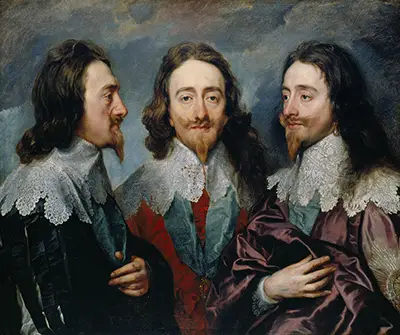 Buy Art Prints Now
Buy Art Prints Nowfrom Amazon
* As an Amazon Associate, and partner with Google Adsense and Ezoic, I earn from qualifying purchases.
Perhaps the most memorable of all King Charles I's portraits, this extraordinary work by Anthony van Dyck captures the monarch at three different angles
King Charles I was a true follower of the arts, building one of the finest collections of Renaissance and Baroque art ever seen. Having begun his obsession by purchasing significant Italian paintings, he then started to desire to be in the paintings himself. Self-obsession was not unusual for monarchs, but King Charles I specfically targeted art as a means to strengthening and controlling how he would be viewed by future generations.
The three positions taken by the King are left full profile, face on, and right three-quarter profile. The clothing varies across each portrait but one item remains within each - that of the blue riband of the Order of the Garter. King Charles I's artistic connections were highly developed by this stage and this painting would be sent to famous Italian sculptor Gian Lorenzo Bernini as a study piece for a later sculpture of the monarch. There was then intended to be a companion piece but the English Civil War put paid to this plan.
This painting was also owned by Bernini and remained in Italy until 1802 when a British art dealer purchased it. It has been in England ever since and continues to be an historically significant artwork which is unlikely to be put up for sale. It is typically on display at Windsor Castle, as part of the superb Royal Collection that spans most signficant art movements since the Middle Ages.
It is the triple-portrait format that makes this painting so memorable, as the artist produced many portraits of the King. It is likely that the inspiration for this three sided portrait came from Lorenzo Lotto's Triple Portrait of a Goldsmith, 1530, which at that time could be found in the Royal Collection. It may have been the King's idea to produce something along these lines, or instead perhaps the artist himself spotted the work whilst perusing the fine collection.



